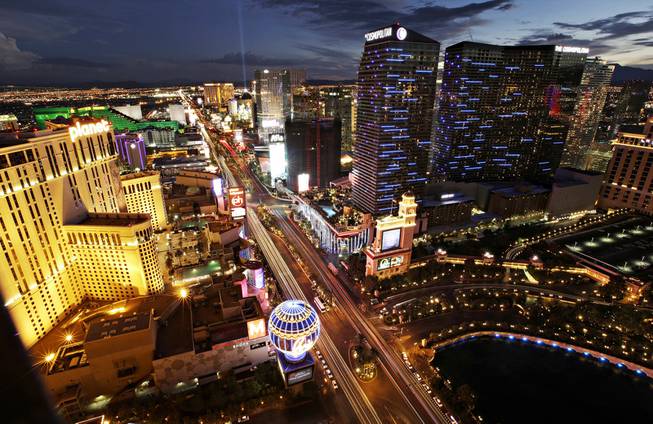
John Locher / AP
In this Sept. 16, 2014, photo taken with a slow-shutter speed, lights of cars blur along Las Vegas Boulevard.
Published Tuesday, Jan. 12, 2016 | 12:04 p.m.
Updated Tuesday, Jan. 12, 2016 | 3:16 p.m.
Why does Las Vegas need light rail?
It would link the airport, the Strip and downtown Las Vegas, a critical connection that would benefit both the economy and the tourist experience, a local transportation official said today.
And it’s the best type of transit to accomplish that goal, according to David Swallow, senior director of engineering and technology with the Regional Transportation Commission.
Swallow told the board of the Las Vegas Convention and Visitors Authority that planners looked at multiple technology options. They eventually recommended light rail because it has the flexibility to be expanded into a larger system, it’s a proven technology that has been used elsewhere and it could draw in “a certain ridership,” he said.
“Light rail systems tend to have a little panache that attracts a different type of rider,” Swallow said.
The light rail proposal is part of the broader Transportation Investment Business Plan that Swallow and Tina Quigley, the commission’s general manager, presented to the authority board today. The plan is expected to be discussed in more detail at the next meeting of the Southern Nevada Tourism Infrastructure Committee later this month.
The billions of dollars required to build and operate a light rail system are not included in the broader transportation plan’s price tag, which could be as high as $12 billion.
Backers of the plan have suggested a light rail system could receive a large amount of money from passenger fares — far more than a typical mass transit system — which may attract investment. Strip public transit already sees a 163 percent farebox recovery rate, according to Swallow’s presentation.
Other proposals from the transportation investment plan include new pedestrian bridges on the Strip, wider sidewalks there, an expansion of the monorail, a possible “circulator trolley” downtown and various road and freeway improvements. The plan also proposes high-capacity transit down Maryland Parkway, which could feature a light rail line as well.
The authority board took no action on the plan today, but it did seek insight about how the proposals will be prioritized.
Quigley said there’s no single group that bears responsibility for carrying out the whole plan and that it will be a community effort.
She said community leaders had already worked together to get the plan to its current state.
“If we can create a culture that is focused on regionalism, a culture that is focused beyond just our own territory, I think we’re gonna be OK,” Quigley said.
Another important body moving forward may be the Resort Corridor Mobility Association, a potential new group suggested by the plan to coordinate on transportation issues. The new group’s members would include representatives from the public and private sectors.
That kind of public-private collaboration may also come in handy when Las Vegas tries to get federal funding for some of these initiatives. At a meeting with local leaders on Friday, U.S. Transportation Secretary Anthony Foxx indicated that it’s important for local communities to work with their business leaders on big transit initiatives.
Foxx knows a thing or two about light rail: he was involved with a light rail project in Charlotte, N.C., when he was mayor of that city.
Earlier during the Friday meeting, which Rep. Dina Titus organized, Foxx said visible signs of progress will help get the public on board, too.
“Once people see it, they believe in it, but if there’s too much of a lag time...the confidence starts to wane a little bit,” he said.

Join the Discussion:
Check this out for a full explanation of our conversion to the LiveFyre commenting system and instructions on how to sign up for an account.
Full comments policy